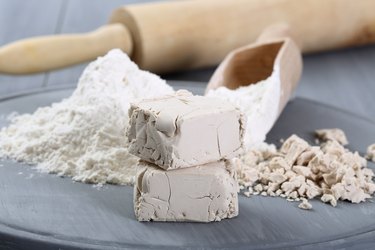
Pure, refined baker's yeast was one of the great culinary advances of the 19th century. Instead of nurturing a finicky sourdough starter a home baker could start and finish bread in just a few hours, getting a reliably high and soft loaf. The earliest commercial yeast was sold fresh, with a shelf life of just a week or two under refrigeration. During the 20th century manufacturers developed dry yeast, which extended yeast's usable shelf life from days to months. However it must be foamed, or proofed, before it can be used.
Active Dry Yeast
Video of the Day
Active dry yeast in your supermarket yeast packet is the same pure yeast found in the soft commercial fresh yeast favored by professional bakers. It has been dried and rolled in a coating made primarily of spent yeast cells, from the vats where the yeast is grown. These little pellets of yeast will return to life once they come into contact with warm water, but in their dry form they remain dormant for months or even years. To return the yeast to its active state, it must be soaked in water, or proofed.
Video of the Day
Signs that Yeast is Viable
Yeast is proofed by placing it in a cup filled with warm water, 100 to 110 degrees Fahrenheit, with a small amount of sugar to speed yeast growth. The water dissolves the yeasts' coating, and the yeasts reactivate as they become hydrated. They begin to consume the sugar they've been provided, as well as their own coatings, and excrete alcohol and carbon dioxide as by-products. The visible evidence of all this activity is a cap of light, frothy foam with a yeasty aroma. Foamy yeast is exactly what you're looking for, because it tells you your yeast is fresh and energetic.
When Yeast is Not Viable
It takes 10 minutes or less for the coating to dissolve, and the yeast to demonstrate itself as viable. Sometimes, though, the yeasts either foam weakly or not at all. The layer of yeast floating on the water does not thicken and become frothy, but forms a thin beige layer on top of the water. If this should happen, check the water temperature first. If the water was too hot it might have killed the yeast. However, if the water temperature is correct, the yeast is no longer viable and must be discarded and replaced.
There's No Easy Workaround
If your yeast is sluggish or doesn't foam at all, don't waste your time and flour trying to coax it into life. There isn't an easy substitute you can use to create a light and fluffy loaf without yeast, so you have just two real options. One is to put your bread-baking on hold while you run to the store for fresh yeast. The other is to shift gears and choose a form of bread that doesn't require yeast, such as flour tortillas or fluffy biscuits made with baking powder or baking soda.
Quick-Rise Yeast
Quick-rise yeast is a newer form of dry yeast, milled into smaller particles. Because of their tiny size, the pellets of yeast absorb water quickly and do not need to undergo the foaming process. Instead it is simply incorporated into the dough as part of the dry ingredients. However, if there is any doubt about the freshness of the yeast, quick-rise yeast can also be proofed in the traditional way. If it foams up properly it can be used in the same way as active dry yeast. If it does not, it should be discarded and replaced.